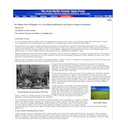 Oguma Eiji, “The Hidden Face of Disaster: 3.11, the Historical Structure and Future of Japan’s Northeast.” Trans. Kyoko Selden. The Asia-Pacific Journal Vol 9, Issue 31 No. 6 (August 1) 2011. Available at http://www.japanfocus.org/-Oguma-Eiji/3583.
Oguma Eiji, “The Hidden Face of Disaster: 3.11, the Historical Structure and Future of Japan’s Northeast.” Trans. Kyoko Selden. The Asia-Pacific Journal Vol 9, Issue 31 No. 6 (August 1) 2011. Available at http://www.japanfocus.org/-Oguma-Eiji/3583.
This article discusses the historical sociology of the Tōhoku region—Japan’s northeast—and how it is the product of a socio-economic structure constructed from c. the 1930s to the 1970s. Oguma traces the legacies of policies practiced by the central Japanese government and Japanese industries in the pre-WWII, wartime and postwar periods. The Tōhoku region used to be a key supplier of Japan’s rice and Tokyo’s labour force in the first decades after WWII. From the 1930s, too, it began to be an important source of Tokyo’s electricity. Tōhoku’s history of being a provider of resources for Tokyo, along with the decline of the coal industry in the same region, led to the Fukushima coast was considered a good candidate to locate nuclear power plants in the 1960s.
The essay ends with a consideration of the impact of globalization on the economic health of Tōhoku and briefly discusses some of the issues obstructing its reconstruction and post-disaster recovery. Oguma points out that the histories of development and decline he summarises in the first half are linked to the complications of reviving the region’s socio-economic health in the wake of Fukushima. Overall, the essay is a useful, condensed portrait of a marginalized region whose existence was supported by being a source of necessities for other places in Japan; at the same time, he weaves the larger perspective of global security issues during the Cold War into the picture. His essay is thus an informative and thought-provoking piece about the ways in which Tōhoku came to be, on the eve of Fukushima, as well as the broader trajectories of state and industry policies in Japan during these decades.
Shi-Lin Loh, Dept. of East Asian Languages and Civilizations, Harvard University
![[Teach311 + COVID-19] Collective](https://blogs.ntu.edu.sg/teach311/files/2020/04/Banner.jpg)